Thai Gourmet and Wine Pairing
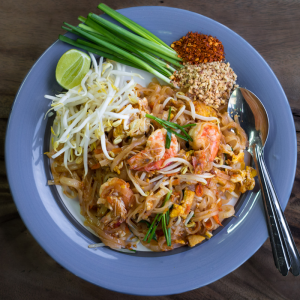 Wine and Thai food — few combinations are as fraught in the East-meets-West culinary world. While Thailand’s unique combination of salty, sweet, sour, spicy and bitter has made its cooking universally popular, these same zesty contrasts can render wine pairings either delicious or jarring.
Wine and Thai food — few combinations are as fraught in the East-meets-West culinary world. While Thailand’s unique combination of salty, sweet, sour, spicy and bitter has made its cooking universally popular, these same zesty contrasts can render wine pairings either delicious or jarring.
Typical Thai dishes have strong tastes and powerful flavors derived from spices and ingredients such as lemongrass, chili, ginger, kaffir lime, garlic, palm sugar and fish sauce. But with so many contrasting flavors, textures and aromas served simultaneously, there’s no chance that any one wine will suit every offering.
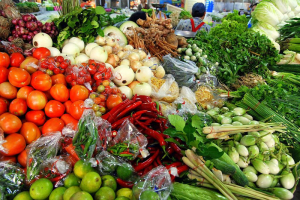 Surprisingly, the consensus from Thai experts is that chili is not the most contentious ingredient. Rather, it’s the herbaceous seasonings and sugar combinations, tinged with lime and coconut, that play havoc with wine pairing.
Surprisingly, the consensus from Thai experts is that chili is not the most contentious ingredient. Rather, it’s the herbaceous seasonings and sugar combinations, tinged with lime and coconut, that play havoc with wine pairing.
Ironically, sweetness in wine is another story all together, actually harmonizing with many Thai dishes. Sugar has long been recognized as a foil to chili spice, so traditional pairing that solely sticks white wine with Asian cuisine is blinkered thinking. White wines with residual sugar, such as Gewürztraminer, Riesling, and off-dry to sweet German and Austrian wines were the established norms.
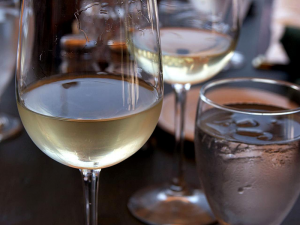 But nowadays, more red wines are coming to the fore, preferably light and slightly fruit-driven.
But nowadays, more red wines are coming to the fore, preferably light and slightly fruit-driven.
But what wine to accompany such a challenging culinary tour de force? Here, the trick is to pair wine with essential Thai flavors, first and foremost. But making that task relatively easy is Sra Bua’s progression of courses, each served and consumed individually, matching five glasses of wine against the same number of dishes. Appetizers are not paired, but a Thai late harvest Chenin Blanc from Monsoon Valley in Hua Hin accompanies myriad desserts. Alternatively, the restaurant offers a teetotal pairing menu of fresh fruit juices.
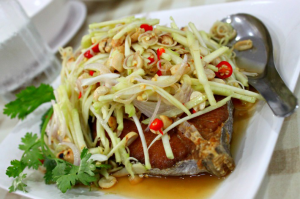 It is the taste of the dish, not the actual meat that decides a good pairing. In Thai cooking, protein has little of the importance afforded it in Western cuisine. The usual rules of white with fish, red with meat don’t apply. Food with high protein would suggest red wine with full body. However, powerful and rich-flavored dishes would suggest wine with a light body and sweeter taste.
It is the taste of the dish, not the actual meat that decides a good pairing. In Thai cooking, protein has little of the importance afforded it in Western cuisine. The usual rules of white with fish, red with meat don’t apply. Food with high protein would suggest red wine with full body. However, powerful and rich-flavored dishes would suggest wine with a light body and sweeter taste.
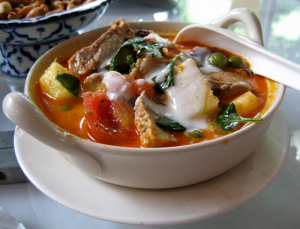 Don’t expect a single wine to work with every Thai dish. Thai food is a lot more spicy in general, and the spices themselves more complex. This makes pairing more difficult, but not insurmountable. The key to matching any food, let alone Thai, is finding balance and harmony between the dish and the wines. Always avoid wines that clash with or overpower the food. Spicy hot food has to go with a spicy white or peppery red wine. Such widely held perceptions are inaccurate.
Don’t expect a single wine to work with every Thai dish. Thai food is a lot more spicy in general, and the spices themselves more complex. This makes pairing more difficult, but not insurmountable. The key to matching any food, let alone Thai, is finding balance and harmony between the dish and the wines. Always avoid wines that clash with or overpower the food. Spicy hot food has to go with a spicy white or peppery red wine. Such widely held perceptions are inaccurate.
Both white and red suit individual Thai dishes, but residual sugar in white is a good foil to most. Off dry (i.e. lightly sweet) rather than actually sweet, and aromatic whites. You also want good acidity, because that ameliorates the sweetness of the wine and also plays well with the food.
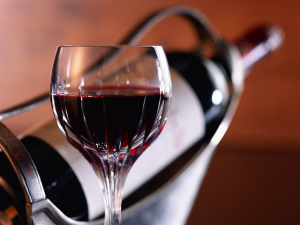 White is safest, as it flatters Thai food flavors. The robust, dry finish with perfect fruit balance makes this a great wine to pair with sweet and sour Thai dishes. These include laab, a hot minced meat salad; Chiang Mai sausage; and som tam, a fiery green papaya salad. All the habitual Sauvignon aggressiveness has been eliminated, retaining a crisp, floral elegance.
White is safest, as it flatters Thai food flavors. The robust, dry finish with perfect fruit balance makes this a great wine to pair with sweet and sour Thai dishes. These include laab, a hot minced meat salad; Chiang Mai sausage; and som tam, a fiery green papaya salad. All the habitual Sauvignon aggressiveness has been eliminated, retaining a crisp, floral elegance.
Light and fresh Pinot Noir, both from Burgundy and the New World, is regarded by many as the most versatile red to accompany Thai food. Other grape types include young Gamay and Grenache. The velvety softness of un-wooded Merlot can also provide unexpected successes. Conversely, avoid big, full-bodied Shiraz/Syrah, the grape famous in France’s Côtes du Rhône, as it fights with chili, coconut and lime juice.
 Likewise, steer away from both Australian Coonawarra and French Bordeaux reds, as they are likely to be heavily oaked and tannic. By contrast, older tannic wines are the exceptions that prove the rule. Bottle-aged Shiraz is much kinder to Thai food than a new vintage. Too often wine aficionados go overboard with dogmatic rules for red wines and Asian foods. The no-tannin rule clearly conflicts with, say, the Chinese marriage of food with tannic tea. Similarly, tannic pea eggplant (makuea puang) cuts the heat and spice of a spicy curry, making it taste sweeter.
Likewise, steer away from both Australian Coonawarra and French Bordeaux reds, as they are likely to be heavily oaked and tannic. By contrast, older tannic wines are the exceptions that prove the rule. Bottle-aged Shiraz is much kinder to Thai food than a new vintage. Too often wine aficionados go overboard with dogmatic rules for red wines and Asian foods. The no-tannin rule clearly conflicts with, say, the Chinese marriage of food with tannic tea. Similarly, tannic pea eggplant (makuea puang) cuts the heat and spice of a spicy curry, making it taste sweeter.
Old world European authorities regularly contend sparkling wine suits Thai food best, yet drinking it across a meal is a minority taste. From Champagne, to Prosecco to Spumante, sparkling wines foil chili, and as demi sec, complement many a curry or yam (salad).
Wine with Asian food is always a controversial subject — at least to Westerners. While a cool, quenching beer works best with the hot spice of chili and the citrus zing of lemongrass and fresh lime, wine also has a role to play in such a marriage of flavors.



 0
0